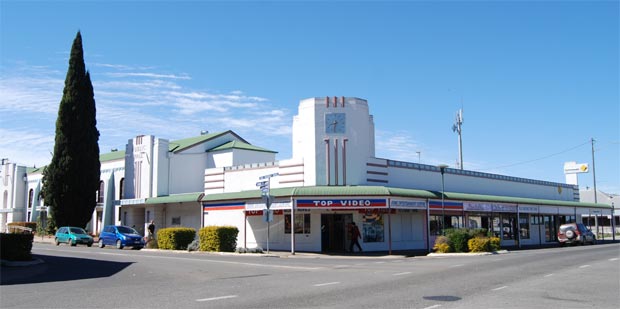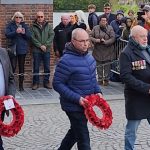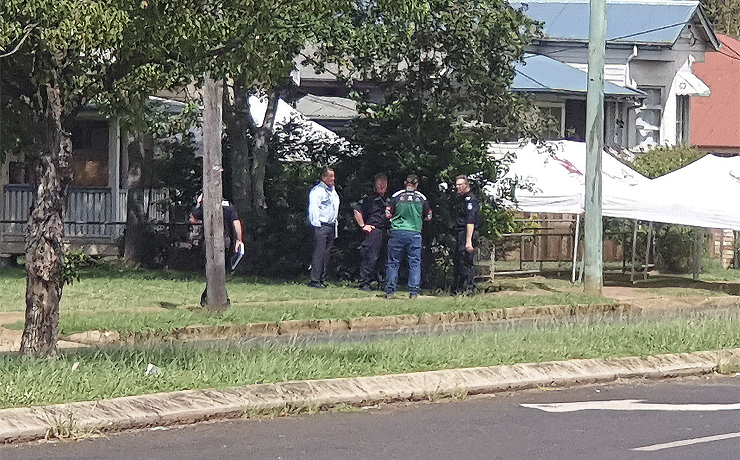
November 13, 2012
The five South Burnett buildings nominated for Heritage listing in August have now been entered into the Queensland Heritage Register.
Environment and Heritage Protection Minister Andrew Powell said today the former Kingaroy Butter Factory, South Burnett Co-Operative Dairy Factory, Shepherd Memorial Church of St Peter, Murgon Civic Centre and former Kingaroy Shire Council Chambers, were important to Queensland’s history.
“I’m pleased to announce the heritage listing of these buildings which are very worthy of protection under Queensland’s heritage legislation,” Mr Powell said.
“Each of these places has a significant story to tell about Queensland’s past.”
* * *
Queensland Heritage Council Chair Professor Peter Coaldrake said the former Kingaroy Butter Factory built in 1926 and the South Burnett Cooperative Dairy Factory established in 1908, showed how Queensland’s dairy industry evolved during the twentieth century.
“The Kingaroy Butter Factory complex demonstrates the principal characteristics and processes of butter production, which was a significant industrial activity in Queensland at that time,” Prof Coaldrake said.
“In the main factory you can still see the loading dock, storage platform, testing, churn, cold storage and packing areas, original mezzanine office, and rear space for the factory’s plant. Adjacent buildings including the cheese annexe, office and ice manufacturing shed, illustrate activities interconnected with producing butter on site.
“The factory was built at a time of modernisation for butter manufacturers, when brick and concrete replaced timber structures,” Prof Coaldrake said.
“The emphasis on making high-grade butter saw the need for more churns to maintain outputs, as well as stricter grading, pasteurisation and neutralisation.”
* * *
The former South Burnett Co-Operative Dairy Factory, one of Queensland’s largest butter producers during the dairying boom, also demonstrates the modernisation of dairy production.
“By the early 1900s, co-operatives –where groups of local producers banded together to establish factories – were becoming the dominant form of ownership of cheese and butter factories,” Prof Coaldrake said.
“This defined the Queensland dairy industry for much of the 20th century.
“The former dairy factory includes the relocated former Tiaro Butter Factory, main building, plant room, boiler shed and stack – all structures that have survived various eras of dairy processing.”
Prof Coaldrake said both the former Kingaroy Butter Factory and the former South Burnett Co-Operative Dairy Factory were fine examples of private owners doing their best to conserve heritage places.
“The owners of these two places should be commended for maintaining these heritage places by keeping them in active use, while also making an important contribution to the economy of the region and showcasing local produce,” he said.
* * *
Prof Coaldrake said the Shepherd Memorial Church of St Peter in Proston, with its Romanesque features, had been listed on the Heritage Register because it was a fine early example of modernism in Queensland church architecture, an architectural style not popular for churches until after World War II.
“St Peter’s Memorial Church remains largely unchanged since it was built in 1939,” he said.
“The modern design makes a striking appearance against the rural townscape of Proston.
“The Anglican church’s architectural excellence and exceptionality was recognised in 1940 with an award from the Royal Australian Institute of Architects Queensland for ecclesiastical and institutional buildings.”
* * *
Prof Coaldrake said the 1938 Kingaroy Shire Council Chambers and the Murgon Civic Centre had been listed as great examples of the State’s history of expressing civic pride through the construction of city halls and other civic buildings in prominent positions during the 1930s.
“Now an art gallery within the Kingaroy Visitor Information Centre, the former shire council chambers in Haly Street is modest and elegant, standing in contrast with the monumental peanut silos located opposite,” Prof Coaldrake said.
“The beautiful craftsmanship of the building expresses the period of prosperity in Kingaroy which resulted from the rapid expansion of dairying, peanut production, and other agricultural activities in the region,” he said.
“Similarly, the art deco and moderne-inspired Murgon Civic Centre built in 1938 is the result of Murgon’s growth as a major service town in the South Burnett during the inter-war period.”
The complex which includes a public hall, library (now offices), shops and a clock tower, contributes significantly to Murgon’s townscape.
“The clock tower stands at the main intersection and its art deco influences – linear forms, stepped skylines, chevron motifs and decorative horizontal banding – enhance its aesthetic appeal,” Prof Coaldrake said.
* * *
Cr Kathy Duff said the South Burnett Regional Council was very proud of the history and heritage of the local region.
“It is wonderful to see five places in the South Burnett honoured for their state significance,” she said.
The Queensland Heritage Council is the State’s independent advisor on heritage matters and determines what places are entered in the Queensland Heritage Register.
Places entered in the Heritage Register are considered of importance to Queensland’s history and are protected under heritage legislation.
Some Fast Facts:
Kingaroy Butter Factory
This building was built by contractors Waugh and Josephson in 1926, replacing an earlier factory established in 1907 on behalf of the Maryborough Cooperative Dairy Company (MCDC).
The MCDC was producing butter and ice at its Maryborough factory from February 1901. During 1905 a group of local Kingaroy dairy farmers met with directors of the MCDC and lobbied for the establishment of a branch factory at Kingaroy.
In the years following construction of the new Kingaroy factory, butter production increased to a weekly peak of 99 tons and 12cwt during 1929-1930, then a record for Queensland butter production.
Between 1927 and 1937 the total number of dairy cattle in Queensland increased by 50 per cent.
By the 1930s dairying was Queensland’s most widely spread agricultural industry and the State’s second most profitable export industry from 1936 to 1941, making up 20 per cent of primary production
South Burnett Co-Operative Dairy Association (SBCDA) Factory
The Murgon butter factory’s diversification into dairy products other than butter from the 1940s enhanced the longevity of the SBCDA operations compared to other factories which became increasingly vulnerable to closure from the 1960s.
Cheese-making commenced at the factory in late 1942 in response to wartime demand, as occurred at Kingaroy, Wondai, and Nanango butter factories.
The Shepherd Memorial Church of St Peter, Proston
The Scandanavian-influenced church was funded by a bequest from grazier Charles Shepherd of ‘Aston’ near Proston. He passed away on June 7, 1935, aged 70.
Charles Shepherd’s body was exhumed from the Proston cemetery and placed under St Peter’s Church in a mortuary chamber shown on the architects’ foundation plan.
The church was designed by architects Fowell, McConnel and Mansfield, supervised by Brisbane architects Lucas and Cummings, and built between December 1937 and July 1939 by LGW Smith, using local bricks.
Murgon Civic Centre
The Murgon Civic Centre was designed by Brisbane architect Clifford Ernest Plant and constructed by Maryborough builder HG Neilsen.
Numerous town halls were built across Australia during the second half of the 1930s as an expression of civic pride when the economy was once again on a more secure foundation after the Great Depression.
In Queensland, the design of these town halls spanned the spectrum from strict axial classicism (Childers) to Goondiwindi Civic Centre’s highly personal and rich Art Deco-inspired style.
1938 Kingaroy Shire Council Chambers
The building of the chambers coincided with the building of the South Burnett’s first radio station 4SB; the opening of a new district office by the Department of Agriculture and Stock; and the erection of the large concrete silos by the Peanut Marketing Board.
The Kingaroy Shire Council continued to operate at the building for more than 40 years.
In December 1983 the former chambers were officially reopened by local State member and Premier Sir Joh Bjelke-Petersen as the Kingaroy District Development Board Tourist Information Centre.
The drawing room of the former council chambers contains many finely crafted elements, walls panelled in silky oak and floors finished with tulip and rose gum parquetry, dais, meeting table, swivel oak meeting chairs, public seating and a map cabinet.
Many shire chambers and town halls of the 1920s and 1930s are fine examples of the influence of modern architectural styles in Queensland townscapes.
- Related article: Five Sites Nominated For Heritage Listing























